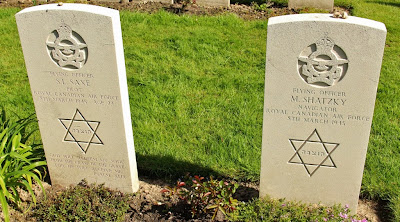Groesbeek is the final resting place of 2338 Canadians who fought in Operation Plunder, the crossing of the Rhine River. General Henry Crerar, commander of the Canadian Army ordered that no Canadian Soldier be buried in German soil. Again, this land was donated for the burial of Canadian soldiers.
This is what the Canadian Army tombstones looked like. Families were given the chance to have something special inscribed on the stone of their loved one. This one has this scripture verse: "Greater love hath no man than this, that a man lay down his life for his friends".
Once again, Jeremy placed a beautiful arrangement on the cenetaph from the Van Dykes.
After spending time in the cemetery, we visited the Liberation Museum in Groesbeek. This book is a rarity! It is illegal to have one in your possession in the Netherlands.
Interesting, we hear so much about the landing in Juno, but not these other landings.
I found this story interesting. Jan Van Hoof (1922-44) was a University student who was determined to save the Waalbridge, and during the fighting at Nijmegen, carried out actions to do this. It is said that he cut the wires to the explosives on the bridge and saved it. He was killed by the Germans on Sept. 19, 1944, guiding a British armoured car. In addition to other decorations, he was awarded the "Militaire Willemorde", the highest Dutch decoration for valour. He is regarded as a hero in this country!
This is what remains of a single person submarine, which carried torpedoes on the sides - at least I think that's what it was! :-)
How would you like to leave your home with only what you could carry on a cart such as this?
The winter of 1944/45 became know as Hongerwinter, when Germany blocked food transports to the Netherlands and 22,000 people died of hunger and malnutrition.
It would break your heart, wouldn't it?
Some boxes were dropped with rations, but some of the things in the packs would make you wonder, "What were they thinking?" Cigarettes, tobacco, candy, gum, etc.
1000's of men plus supplies were dropped by parachute near here in a huge field.
There was obviously a LOT of parachute material around, so the locals made good use of it!
A baby's christening gown - the centre panel is made from parachute material as well.
I like this one - it was very true!
This unusually shaped part of the museum was meant to represent a parachute, because they were a really important part of the Liberation of this area. This was simply labeled "Resurrection". After a scrumptious meal at a local country club (the golf course had 45 holes!), we were taken on a coach tour, with local guides, to retrace the steps of the Canadians on their instrumental actions that enabled the Allied Forces to cross the Rhine River in Operation Veritable. This is a recreation of one of the many gliders that landed on this field bringing supplies and equipment. Can you imagine the excitement of the locals seeing these and 1000's of troops parachuting in? Wow! As we drove along the road in places, it was Germany on one side of the bus, and Netherlands on the other side. You could still see many of the trenches from the fighting. Germany had the advantage of woods, when the allies often had no cover.
Along the way, we visited another war cemetery in Germany called the "Reichswald Forest War Cemetery" where many of our airmen are buried. Army people were all moved from Germany, but not so the airmen. These 2 stones say that the men represented are buried "near this spot".
This is the whole crew of a plane that went down, with the captain slightly to the left of the others.
Most of the stones have crosses - these were obviously Jewish boys.
Jeremy is very knowledgeable of all things "war", and I love to listen to him tell about it!
We stopped at a farm on land where a lot of the fighting took place, and this high point was where the generals kept an eye on what was going on. I THINK they said there was even a platform in a tree where they watched from - like the one above. They would certainly have a good view of the surrounding area from there. Apparently the farmer had found 1000's of land mines over the years - learned to recognize the way the grass grew where there was one.
The farmer's dog would have fetched that stick all day, I think!
The back of one of our beautiful Mercedes coaches.
......until next time.......


























No comments:
Post a Comment